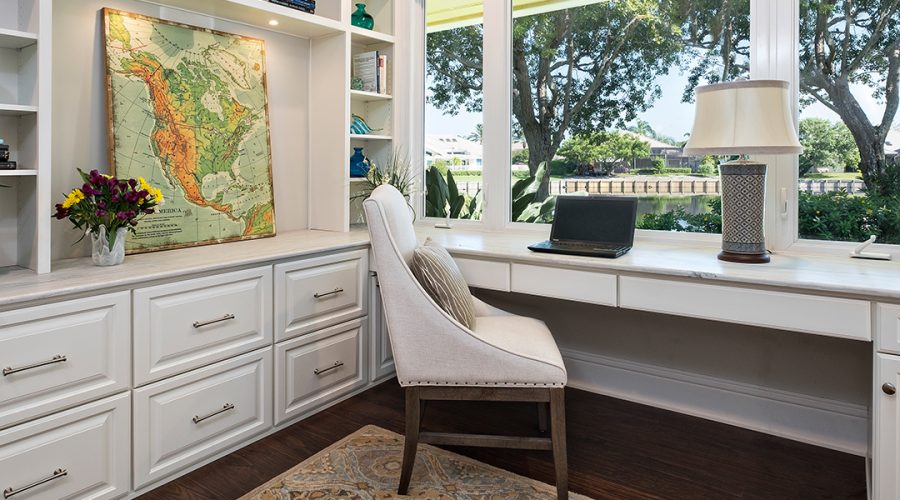
In the age of remote work, a home office has become more of a necessity than a luxury. Whether you work from home full-time or part-time, having a dedicated space for work is essential for productivity and comfort. Here are some remodeling ideas to create a home office that is both functional and comfortable.
Choosing the Right Room
When it comes to creating a home office, choosing the right room is crucial for productivity and comfort. While it may be tempting to convert a spare bedroom or use a nook in the living area, it’s important to consider the potential distractions and noise levels in these spaces. Instead, opt for a room that is quiet, private, and free from interruptions.
Once you’ve selected the ideal room, consider the layout and design of the space. A comfortable and ergonomic chair, adjustable desk, and proper lighting are essential for productivity and avoiding strain or injury. Additionally, incorporating elements such as plants, artwork, and personal touches can help create a welcoming and inspiring atmosphere.
When it comes to color and decor, choose shades that promote calmness, such as blues, greens, and neutrals. Avoid bright or distracting colors that may hinder concentration. Consider adding storage solutions to keep the space organized and free from clutter, such as floating shelves or a filing cabinet.
Finally, don’t forget to consider the practical needs of the space, such as reliable internet access, power outlets, and a good ventilation system. With these key factors in mind, creating a home office that is both functional and comfortable is within reach.
Investing in Comfortable Furniture
Investing in comfortable furniture is a great way to create a home office that is both productive and comfortable. Consider purchasing a comfortable chair that supports your back and neck. This will help you avoid discomfort and strain during long periods of sitting. A standing desk is also a great investment that can help you avoid the negative health effects associated with prolonged sitting.
Another factor to consider when designing your home office is lighting. Natural light is best for productivity, but if this is not possible, invest in a good quality desk lamp. The right lighting can improve your mood, reduce eye strain, and help you stay focused.
In addition to furniture and lighting, consider the layout of your home office. Keep it organized and clutter-free to help you stay focused and avoid distractions. Use bookshelves and storage bins to keep everything in its place.
Lastly, don’t forget about the importance of décor. Add plants, photos, and artwork to make your home office feel inviting and inspiring. A pleasant and visually appealing environment can boost your mood and help you stay motivated.
Creating Adequate Storage
A cluttered workspace can be distracting and hamper productivity. Therefore, creating adequate storage is essential. You can install shelves, cabinets, or even a bookcase to store your books, files, and office supplies. A tidy workspace can help you stay focused and minimize distractions.
To start, consider installing built-in shelves or cabinets to house books, documents, and other items. This can help keep your work area clean and free of clutter. You can also add a desk with drawers or a filing cabinet to keep important papers organized and easily accessible.
Another option is to incorporate storage solutions that are both functional and stylish. For example, you can add floating shelves that double as decor, or install a pegboard to hang tools and supplies. These options not only create additional storage space, but also add visual interest to your home office.
Finally, remember the importance of lighting. Good lighting can help reduce eye strain and improve mood, which can lead to increased productivity. Consider adding a mix of natural and artificial lighting to your home office, such as a desk lamp and large windows.
Incorporating Lighting
Creating a home office that maximizes productivity and comfort is vital for anyone who works from home. One important factor to consider when remodeling your home office is the lighting. A well-lit workspace can make a significant impact on your overall mood and productivity.
When choosing lighting for your home office, consider the color temperature of the bulbs. Cooler temperatures, such as daylight or cool white, are ideal for workspaces as they promote alertness and focus. Warmer temperatures, such as soft white, can create a cozy atmosphere but may not be suitable for work environments.
Another essential factor to consider is the placement of your lighting fixtures. Avoid placing lights directly above your computer screen or in a way that causes glare or shadows. Instead, aim for even and indirect lighting that illuminates the room without causing eye strain.
Add some personality to your home office with decorative lighting fixtures. A stylish desk lamp or a unique pendant light can add a touch of flair and personality to your workspace. However, be careful not to go overboard with decorative lighting as it can be distracting and affect your productivity.
Incorporating lighting into your home office remodeling plans is crucial for creating a productive and comfortable workspace. Choose the right color temperature, consider the placement of your lighting fixtures, and add some personality with decorative lighting to create a space that inspires you to work efficiently.
Adding Personal Touches
When it comes to personal touches, adding decor and accessories can help make your office feel more inviting and inspiring. Hang artwork or photos that inspire you, add a comfortable chair or rug, and incorporate plants for a touch of nature.
Consider adding elements that promote physical health and comfort. Invest in an ergonomic chair and desk to reduce strain on your body. Add a standing desk or exercise equipment to encourage movement throughout the day.
In conclusion, creating a home office that is both functional and comfortable requires careful planning and attention to detail. By choosing the right room, investing in comfortable furniture, creating adequate storage, incorporating lighting, and adding personal touches, you can create a workspace that is conducive to productivity and comfort.





